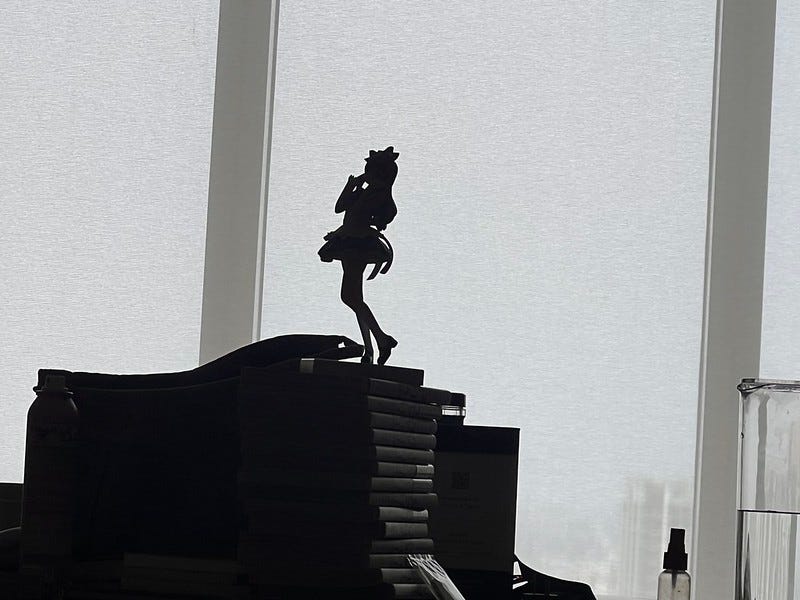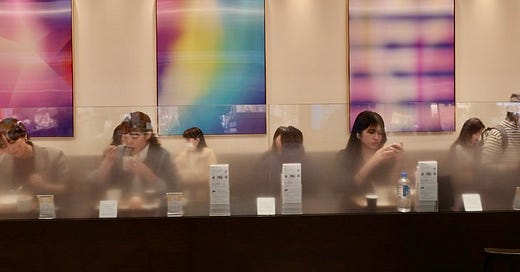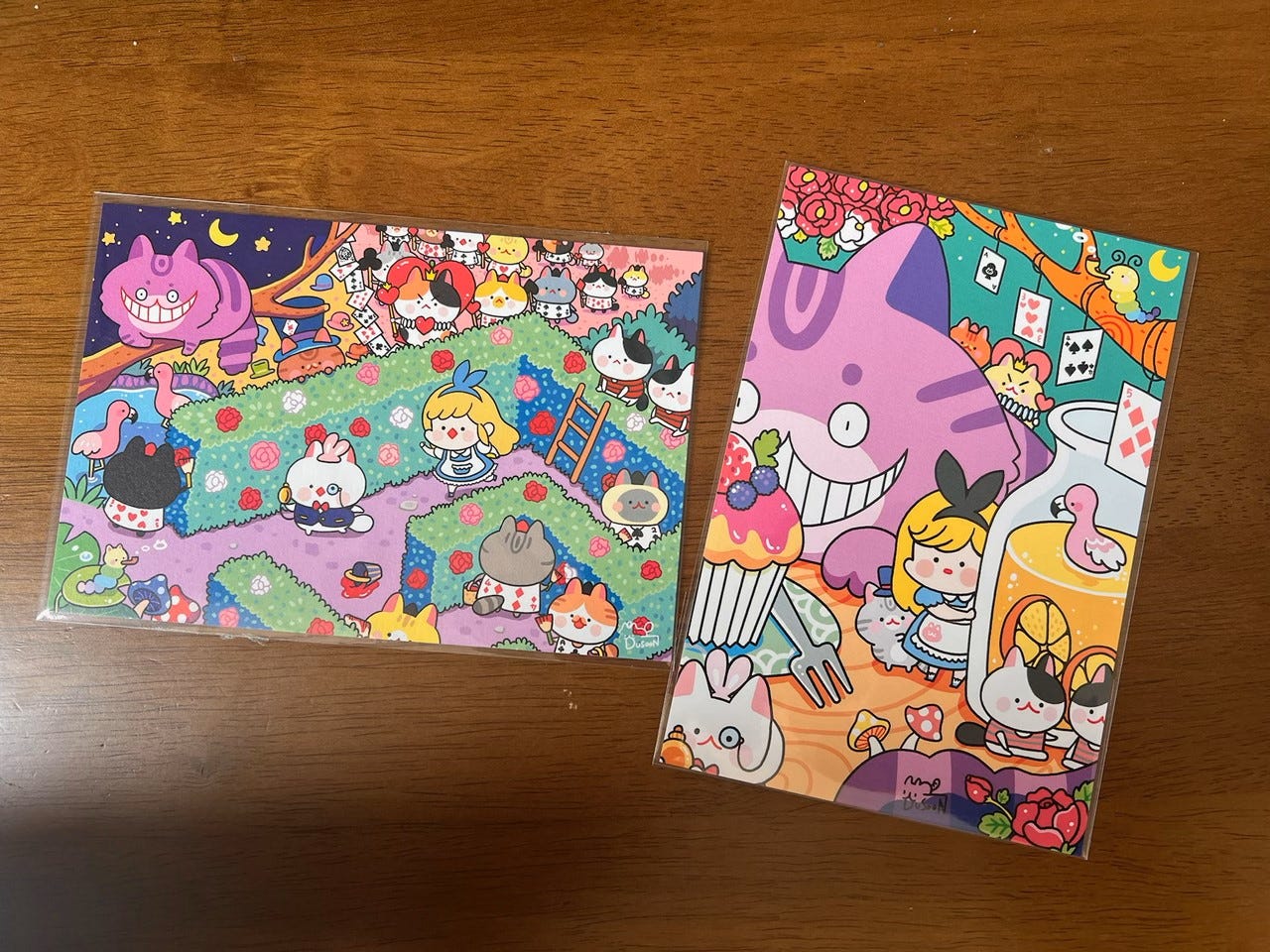Usually in Alice & The Eggmen, we’re tracing connections between Lewis Carroll and the Beatles, looking for patterns of influence, both direct and more subterranean. This week’s instalment’s a curio, though. I’m just back from holiday in South Korea & Japan, and have plenty to report back on. Both about the Beatles and Alice, which are iconic in Japan especially, but not so much connected. So humour me while I just share some little finds from my trip, as I sought to spice up the more traditional sight-seeing with some culture hunting.
[More trip photos here for anyone who’s interested in the non-Alice stuff].
What was bizarre, was how the trip kicked off, with our Seoul hotel (Le Mong). I wasn’t expecting anything here except for a decent room, and yet it was full of Lewis Carroll - from quotes on the walls, to tea cannisters. All very traditional stuff of course.



And then, among the bric-à-brac in the breakfast room, I spotted this - as though someone knew I was coming and was pranking me. Of course, I think it’s just a reflection of Western tastes with a slightly retro feel, but interesting nonetheless; both recognisable by Western travellers, so perhaps it’s just making people feel at home, away from home.
Seoul searching…
In every city I tried to drop into bookshops and ask where the Lewis Carroll section was, which was often rewarding, and sometimes frustrating, if only because many of the editions are either childish versions or things I already own in English - like the wonderful Yayoi Kusama volume.
What I found nowhere — though that’s on me I’m sure — was shelves and shelves of interesting editions. And this despite the fact that we know — from Amanda Kennell’s really excellent Alice in Japanese Wonderlands (that I carried around with me) that there have been over 500 Japanese versions. I think I had a naive dream of sitting with second-hand booksellers for hours, poring over a huge pile of rare editions. Again, that’s on me. As we’ll see later it’s the manga / anime where it became more interesting - but I digress…
Back to Seoul and on day 2 in Insa-Dong, I started noticing all kinds of Korean Wonderlands. Here in postcard form in a ‘cute’-style souvenir shop.
Of course I love the way cats are everywhere (and we should remember that the Japanese Hello Kitty empire was named after Alice’s “kitty”).
Later my wife, Katherine, spotted these in another Seoul bookshop while I was rifling through copies of seemingly more popular Anne of Green Gables in the hope of finding my Arisu…
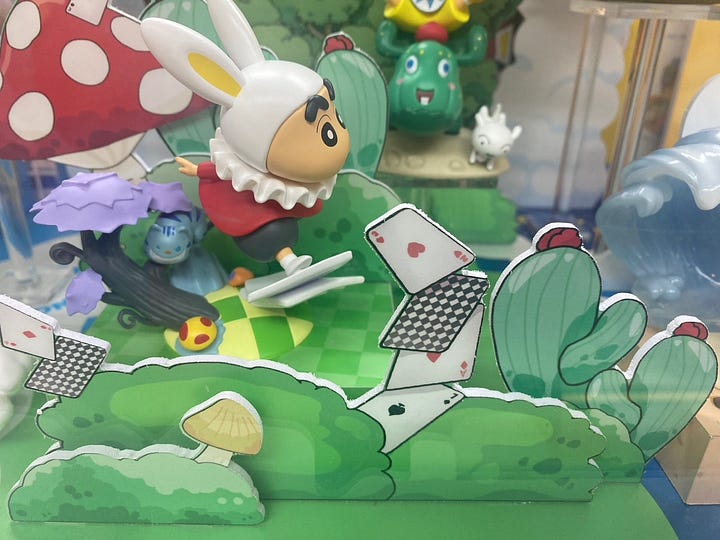
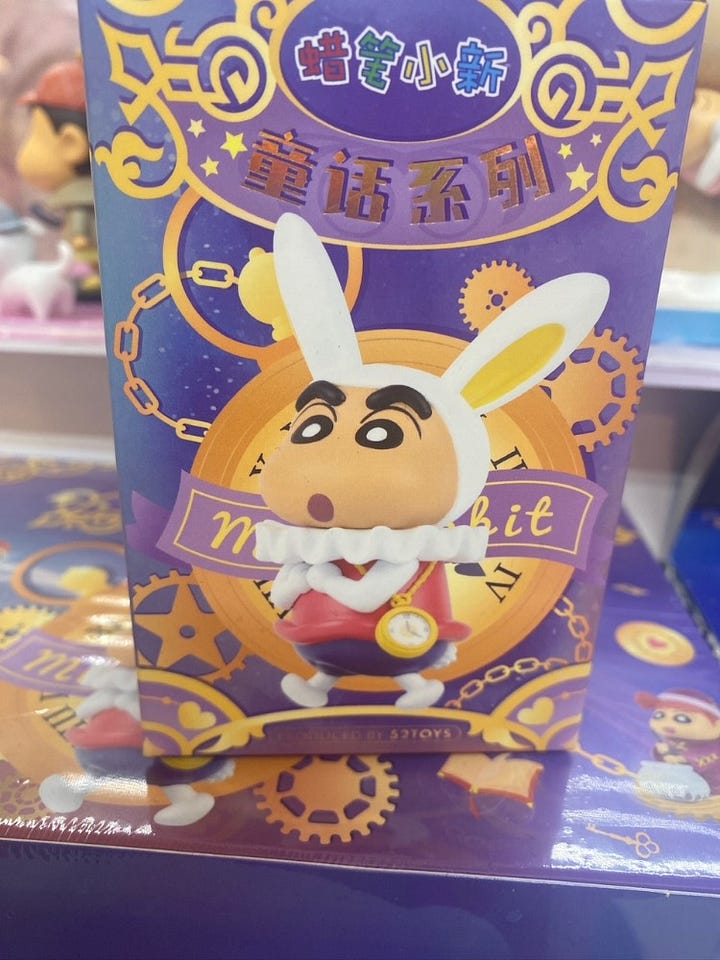
I did also manage to snap up this Korean edition for the collection. It’s a small format hardback, which is another feature of Asian book publishing we’re not as used to, with beautiful illustrations by Min Ji Kim.
And so to Japan.
No time for book-hunting in Hiroshima — we had better things to focus on, from Shinto shrines to islands to the peace memorial — but it’s quite hard to fully escape Disney and I did spot these in one of the convenience stores…
So I had to wait till Kyoto for my next collector’s dopamine hit.
If Alice is popular in Japanese culture — albeit transformed through the lens of Japanese folklore and culture — then the Beatles are equally iconic, but in a very different way. Let’s not forget the role played by Yoko Ono, daughter of wealthy Japanese bankers, in the story of the Beatles, nor the influence of Japanese language and music on John’s output. Or the critical role played by the Beatles in galvanising Japan’s relationship with the West:
Following their first tour to Japan in 1966, the Beatles would become an important part of Japan’s postwar cultural development and its deepening relationship with the West. By the 1960s Japan’s dramatic rise in prosperity and the self-confidence of the country’s ‘economic miracle’ period were yet to come; it was not, at this stage, considered a fully-fledged partner of the West. All these potential developments were consolidating around the time of the 1966 tour. The Beatles' concerts in Tokyo contributed to the construction of a new Japanese national identity and introduced Japan as a new potential market to UK and US music producers, broadening the country’s transnational cultural links.
-Caroline Stevens, The Beatles in Japan, 2017, abstract.
So I was really happy to snap up this post-breakup tribute volume from 1974 in a lovely backstreet art & photography specialist’s called Books & Things, in Gion.
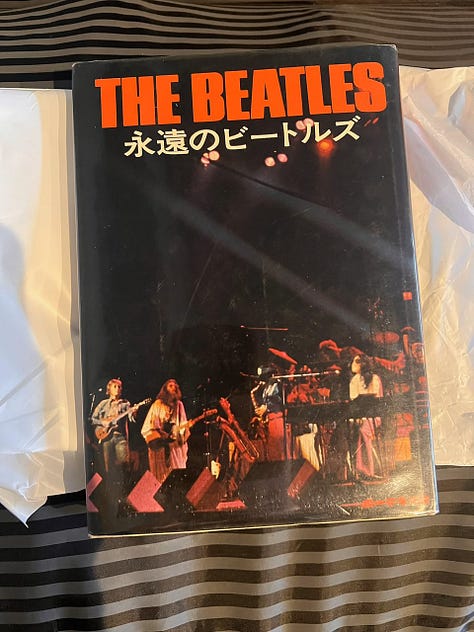
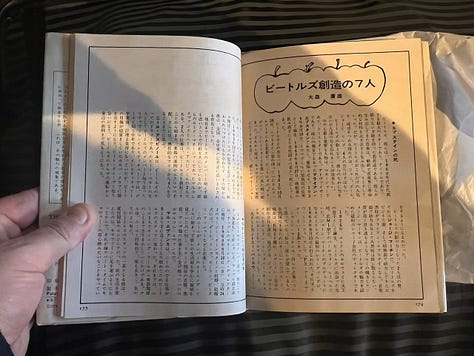
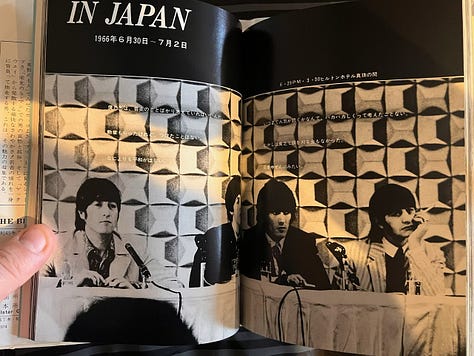
You can find the shop here.
In Tokyo, where our trip ended, two of my (related) highlights were an evening at “Abbey Road” — a club that’s devoted to Beatles covers bands and shopping at Perfect Circle, a record shop in Shinjuku, that exclusively deals in Beatles and Beatles-related products.
“Abbey Road” is plush - it reminded me a little of Ronnie Scott’s. And we saw the main band - The Parrots - perform 3x 30-minute sets to an adoring audience, who not only watched with rapt attention, but had a whole routine of co-ordinated clapping patterns I’ve never heard before. Paul McCartney hired The Parrots to play at his wife’s birthday in Tokyo, and countless other celebrity musicians have visited. A woman at the table next to me told me she’d been coming twice a month for 20 years. And I got a selfie with ‘George’.

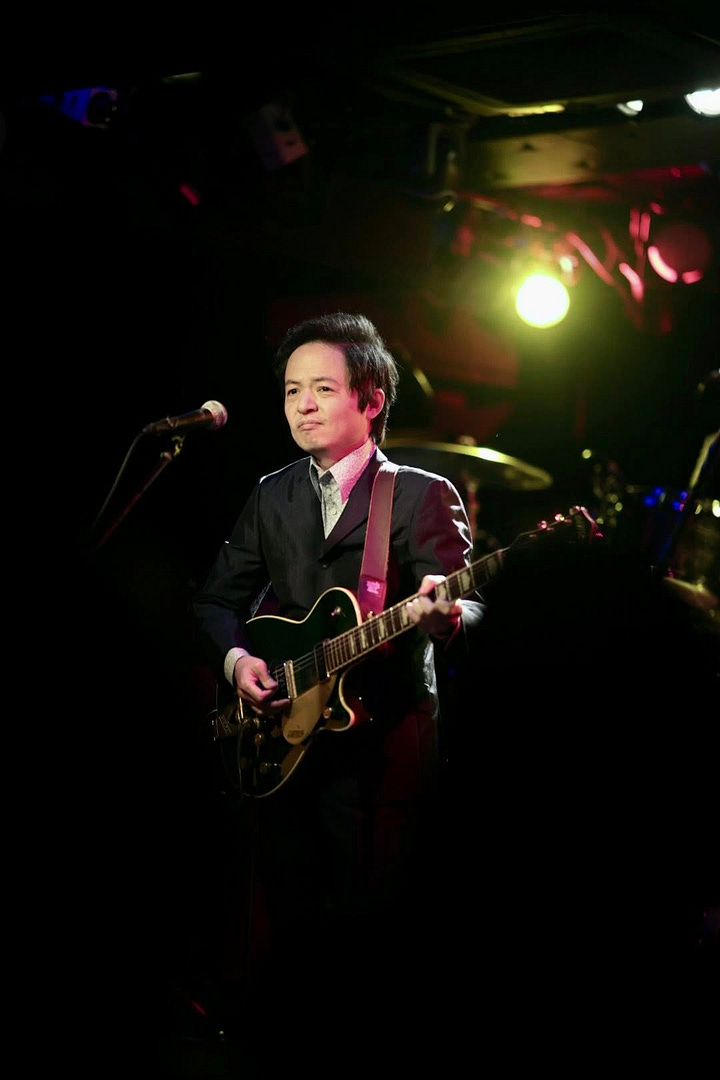
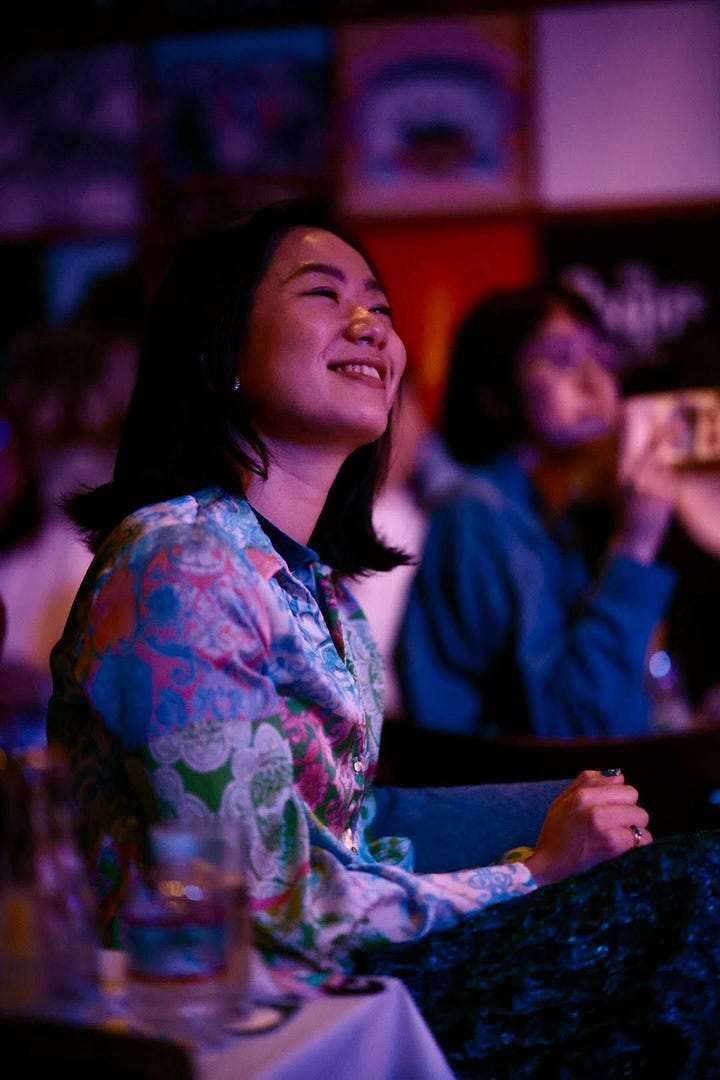
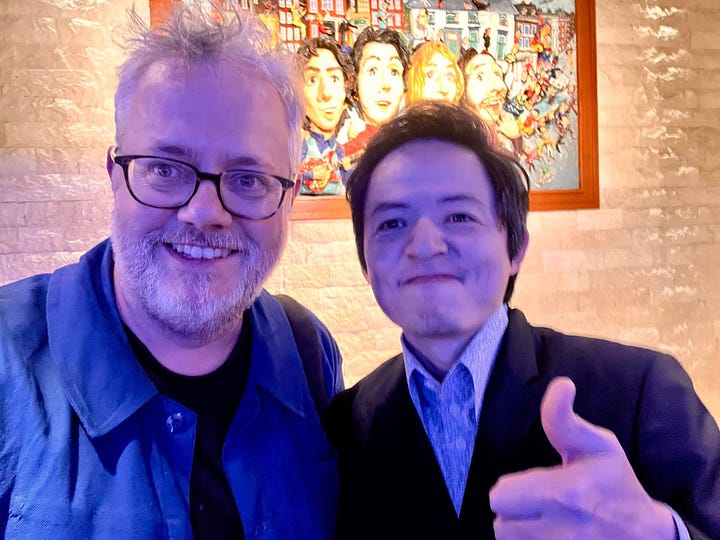
At Perfect Circle, up a metal staircase and 3 doors along in an anonymous corridor on the 5th floor, I found some reproduction memorabilia (tour programmes from 1963), but more importantly, uniquely Japanese releases (one EP and Beatles No.5, an ‘album’ from 1965) that are printed on red wax (vinyl). All for a fraction of the cost on eBay.
I can’t recommend this shop highly enough, nor its knowledgeable owner Aiko. You can find it here.
But back to Alice. One of the things you’ll see represented a lot is rabbits (usagi) and sometimes white rabbits (shiro-usagi). I have a hard time disentangling the different kinds. Serendipitously, today on FB, Alice Chapman gave a great summary about rabbits in Japanese folklore:
Rabbits in Japan are usually metaphors for the moon, as there is a Japanese folk tale about a rabbit on the moon who makes mochi. They symbolize longevity, good luck, and prosperity. You'll also see rabbit deities in some Shinto shrines and these are usually prayed to for fertility. Rabbits are also seen as messengers to the gods.
-Alice Chapman, Lewis Carroll Society Facebook group discussion.
On the other hand we have the ‘obviously Alice’ White Rabbits:
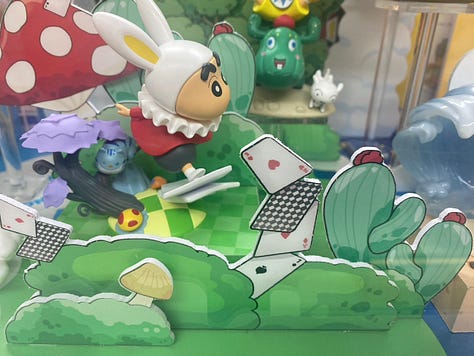
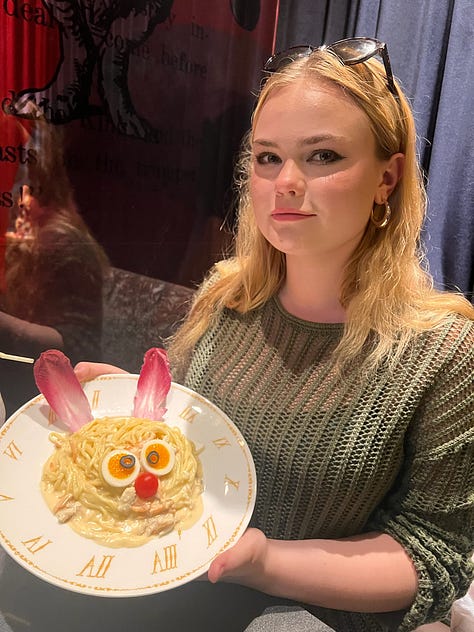

But just as Lolita-style outfits, Victoriana, and Alice intersect, so do many other rabbits, I feel. Strolling through the streets of Osaka and then Kyoto, I encountered these other kinds of rabbit figures, often red-eyed (albino) creatures with a more other-worldly ‘vibe’.
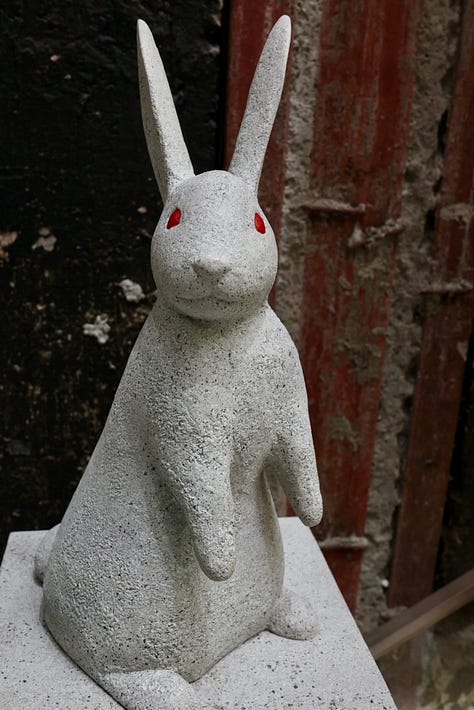
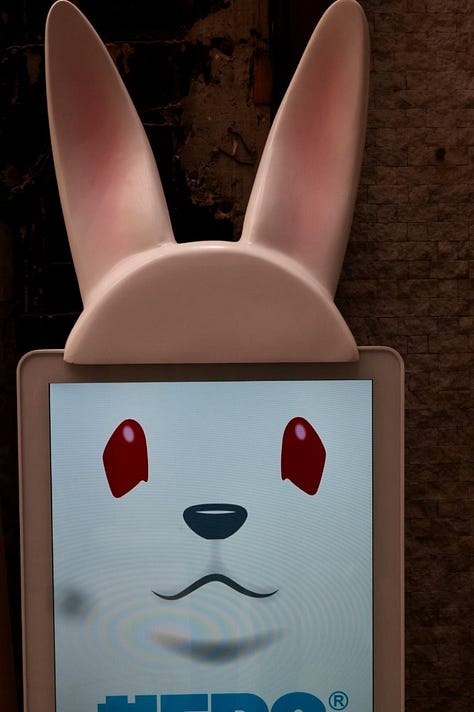
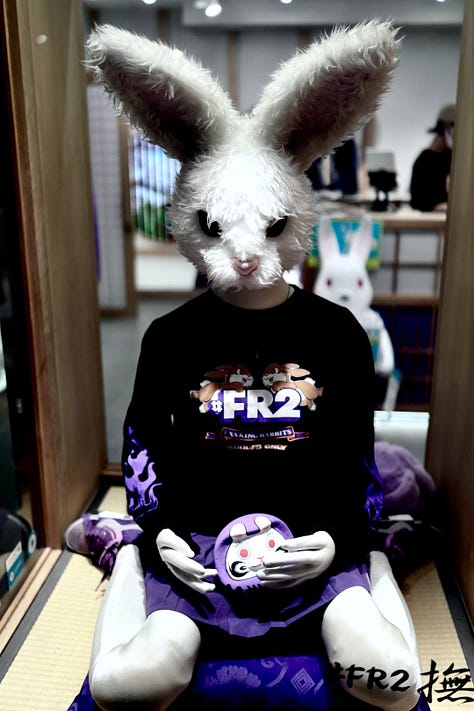
I should probably know better, but I invoked Chat GPT’s help, in “deep research” mode (which is actually quite impressive).
Up for discussion and for people who know this area much better than me to chime in, please, here’s what Chat GPT concluded about red eyes (my selection of key points):
connote “sacrifice or suffering […] otherworldliness […] prophetic vision”
in anime / manga can symbolize time travel, mystery or madness
show up in some of the twisted, horror/fantasy versions of Alice in Wonderland
they blur the line between trickster and helper…
and represent ‘glitches’ in reality
Since Japan reinvents and assimilates Alice over and over, I’d love to hear more on this topic. It led me to other shops…
Navigating the mecca of manga…
These places are magical, but also maddening, and inevitably hard to navigate when you lack basic Japanese and also a good understanding of Manga culture, like me. Fortunately I found my own guides wherever I went, who were always up for searching databases and a google translate dialogue.
Most of us have heard of or watched Alice in Borderland, as it’s been screened on Netflix, but I was happy to find 14 of the 17/18 volumes in one of the amazing Book.off outlets in Tokyo. Here’s the moment of discovery


I also spent quite a lot of time in the Akihabara branch of Mandarake, which so reminds me of a sub-culture feeling about London in the 80s/90s which was stuffed full of second-hand record, book, clothes, model shops. Mandarake does all of that and more - couldn’t recommend it highly enough.
And again, after a lot of back-and-forth in the manga floor, the assistant and I finally tracked down these two beauties from the Dark Alice series by, which I’ve yet to digest properly. That Shiro-Usagi definitely looks a little more sinister than usual!

While I was at it, I also tracked down English-language volumes of the Heart no Kuni no Alice series (Alice in the Country of Hearts) on eBay. What I couldn’t find was Alice in Murderland which has this synopsis:
“At one of the family's monthly tea parties, their parents announce that the children must now fight to the death within the next year, with the sole survivor being chosen as the family's heir. In the ensuing chaos, Stella's violent alternative personality, Bloody Alice, begins to resurface in Stella's clashes with the other children. As the series progresses, Stella learns that her adopted family are actually bandersnatches, creatures that feed on human souls, and that they require the tea at the monthly tea parties to survive.”
There’s a LOT more to explore, to say the least. Amanda Kennell’s book has extensive commentary on the whole anime / manga field, but I found things like these lists quite helpful too: 10 Manga With An Alice In Wonderland Theme.
And so to the odder, and to my mind, slightly more disappointing, superficial and sometimes seedy manifestations.
Things like Alice-themed Maid Cafés…
I tracked down this one in Akihabara. It’s called Alice Party, and like other local cafes, has a complex pricing “system” involving paying over the odds for the promise of cosplay / service in a fantasy setting, but with a fine line between entertainment and something much more unwholesome. The maids were not outside when we passed, and we didn’t feel the need to go in. I’m sorry - but you’ll have to try for yourselves if you’re more curious than I am.






PS - there was at least one more next door and some that seemed to have closed temporarily. I was happy to move on.
Alice-themed restaurants
So instead I visited Alice in a Fantasy Book in Shinjuku (160-0021Kabukicho1-6-2, T-wing Bldg. B2), purely because it was the most convenient for me (so I can’t speak for Alice in the land of the Old Castle, or Alice in Fantasyland, but it’s the same company and similar concepts).
There were previously 5 concept restaurants in Tokyo, but now only 3 remain. And I can see why that might be the case. Basically you can thank me for going to one, so you don’t have to!
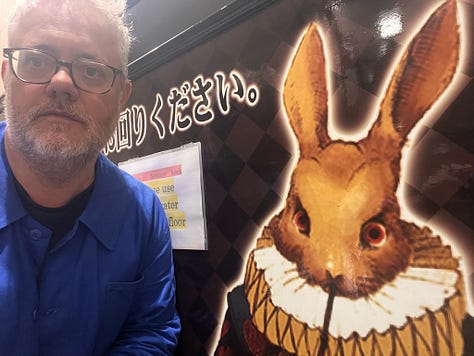


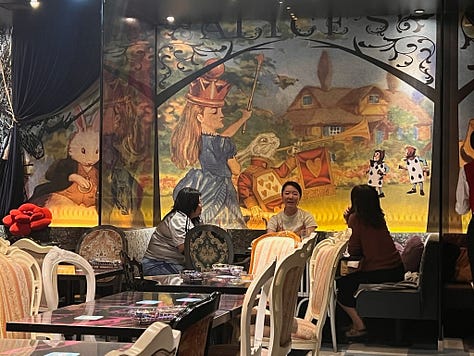

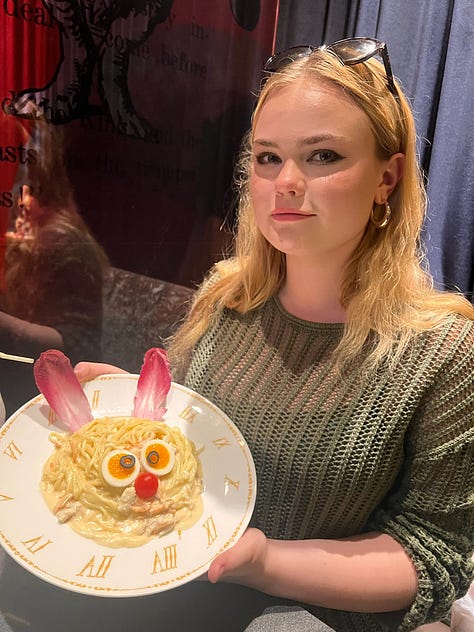
My verdict?
Well, the concept’s cute, in its own way, with floor to ceiling artwork, structures, models, themed menus and drinks, uniforms and more. You have to give them extra points for effort, and I can imagine things like kids parties feeling special here.
And yet — in a country absolutely oozing with deep and delicious, high-quality, food — this is a quite disappointing eating experience (neither deep nor delicious). My omelette stuffed with rice and a beef stew on the side, topped with a black taco “hat” was underwhelming, while my daughter’s salmon spaghetti - complete with white rabbit radicchio ears, and egg / olive eyes — was very salty-fishy (never a great combo). Cocktails were overly sweet to my tastes, but I did enjoy the ceremony of the hatter’s teapot. And if you’re looking for wall-to-wall thematic consistency, then this might just be the place for you!
Shopping for Alicery
While in Shinjuku I also thought I’d check out some Alice retail. Previously — and still in Fukuoka and Nagoya — a 3-story shop with magical entrance, Alice on a Wednesday is now a store-within-a-store at the 0101 Department Store, which also contains a fashion brand, selling Lolita-style apparel, called Alice & The Pirates.
Anyway, if you like the idea of Alice-branded teas, jewellery, trinkets and that kind of thing, you’ll be delighted. That’s so far from what I find interesting about the world of Alice that I couldn’t bring myself to buy anything (although I do already own a tea-towel and a fridge magnet from other places (yes, guilty as charged!).

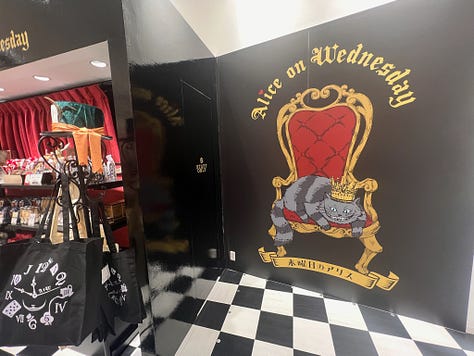
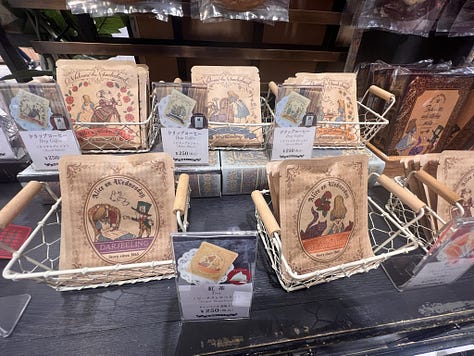

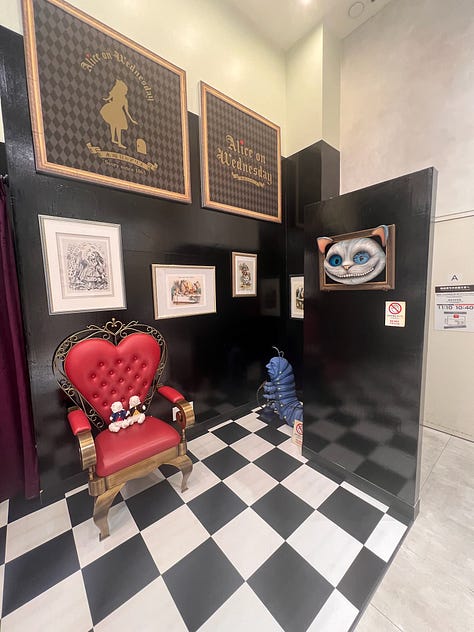

I can never resist a Cheshire Cat grin, which is maybe a good place to leave it.
I’m sure many of you know much more about this, and can shed more light on comics, cafes and , or have your own travel stories to share. Let me know in the comments.
See you next week for a proper Alice / Beatles post. Hope this was distracting at least!
